 Overview
of the WSM Project Progress Overview
of the WSM Project Progress
|
1
Abstract
|
|
The completion of the first 18 months of the WaterStrategyMan
Project (Developing Strategies for Regulating and Managing Water Resources and
Demand in Water Deficient regions) has seen the fulfilment of a number of the
project objectives, and the extraction of significant results.
|
This document is a
summary overview of the project progress thus far, including a description of
the work undertaken and the most meaningful project results obtained.
|
2
Introduction - Project Objectives
|
The WaterStrategyMan Project aims at
contributing to the solution of water shortage problems in arid and semi-arid
regions of Southern Europe. Some issues related to the arid conditions are
recurrent in these regions [1],[2],[13]. In most, the presence of continuous
sources of water stress is combined with periodic droughts; the limited amount
of rainfall is not sufficient to support the local agriculture. New
infrastructure needs to be built to deal with the issue of ensuring and
providing an adequate supply. Yet infrastructure planning is made on the basis
of average years and deviations from those, but cannot be made to accommodate
infrequent/rare events and thus these events are not dealt with adequately.
This in turn raises the question of
adequate institutions and administration that enable the development of such
infrastructure as well as the imposed economic burden. Further compounding the
problem, the coastal regions, where the unevenly distributed population tends
to concentrate, are an attractive tourist destination. Massive numbers of
tourists arrive and stay for a short time period and infrastructure planning
needs to take into account the seasonal peak; but this creates the issue of
recovering the cost of the infrastructure, and who will pay for it, as part of
the year-round maintenance and use.
The local societies often mistrust the
relevant authorities and/or other interested parties, and therefore tend to
view the potential for joint actions in a negative light, preferring to address
the issue locally. In fact, in a number of regions there are no clear water
policies defined, and a general lack of long term planning with respect to the
development and conservation of aquatic resources. The available resources tend
to be exploited in a manner that suggests no systematic long term management.
The different demands for irrigation, domestic use, tourism and industry use
are constantly competing for the scarce resource (due to many reasons, such as
differential water pricing, importance to the economy coupled with their
strategic significance for further industrialization and modernization).
The decline of water resources and
increasing demand for freshwater cause threats to the environment and provoke
conflicts between competing and conflicting users, even in comparatively
water-rich areas. Appropriate water management tools, decision-making practices
and thoroughly-planned interventions are necessary for increasing the
availability of supply and/or managing the growing demand, and the project
seeks to develop and evaluate strategies and guidelines towards integrated
water resources management in the Southern European Regions.
|
The steps in which this task is being
undertaken are the following:
1. The formulation of a Typology for
arid and semi-arid regions, highlighting the commonalities and gaps among
regions of southern Europe, and defined in terms of water deficiency types,
2. The conceptualising
of these into the corresponding water management Paradigms, (Paradigm is a
school of thought on prioritizing during the selection of Policy Options for
the Management of Water Resources) relevant to the regional context, and
addressing:
3. The selection of a set of
representative regions that will be used to analyse and evaluate Integrated
Water Resources Management (IWRM) options,
4. The definition of six complementary and non-overlapping Case Studies
according to the:
5. The adaptation of tools able to
analyse quantitative and qualitative impacts and intersectoral competitive
water use, and to describe potential responses and water policy consequences,
6. The suggestion of appropriate
responses to water stress and implementation alternatives,
7. The development of improved water
management strategies, and
8. The formulation of widely applicable
guidelines and protocols for their implementation.
|
3
Project Structure
|
The Project is structured in four
distinct but interrelated phases (fig. 1). The first two Phases, now completed,
involve the Analysis and development of a Methodology, while Phase 3 deals with
the Case Studies and the Formulation of Strategies, and Phase 4 involves the
Synthesis and Dissemination of project results.
|
The project in its entirety is
undertaken in thirteen Work packages (fig. 2).
|
|
 \ \
Figure 1: Project
Phases
|
|
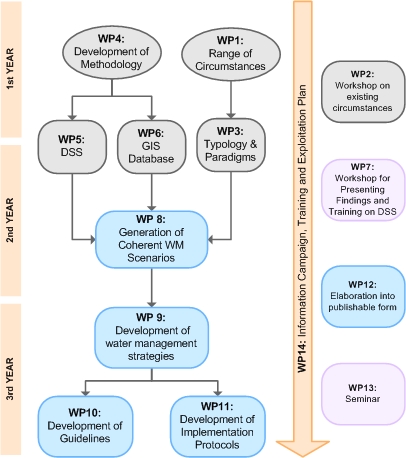
Figure 2: Work Package Interrelationship
|
3.1
Research approach
|
The adopted research approach is based
on the successive generalization resulting from systematic analysis of specific
conditions. The analysis alternates between the generalized and the specific
element (see fig. 3). On the basis of a generalised concept for aridity, the
analysis of specific regions tried to provide "lessons" that were used to
develop Regional Models, to be further analyzed through the Case Studies.
|
The Case Studies are expected to yield
results that can be used for a broad spectrum of similar regions, in the form
of Strategies for Integrated Water Resources Management, Guidelines and
Protocols of their Implementation.
|
|
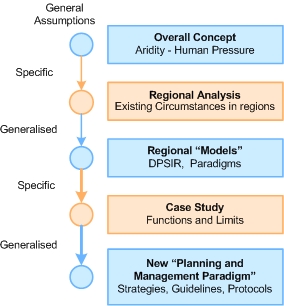
Figure 3: The Project Logic
|
4
Project results
|
The first two phases of the Project
have seen the development of a well structured methodology for the analysis of
water stress conditions in terms of Indices, the determination of Causal
Interrelationships in a DPSIR scheme (Drivers, pressures, State, Impacts and
Responses [16]), and the incorporation of Data structures in a GIS database.
The analysis has been applied in the Case Study countries, and data, databases
and DPSIR schemes have been developed for 15 water stressed regions within
those, with the purpose of moving into the next phases of developing common
implementation guidelines.
The Diagnostic/Descriptive analysis was
undertaken in 4 levels:
1. The 1st Level
involved the Comparative analysis of water stress conditions in six Southern
European and Mediterranean countries (Greece, Italy, Spain, Portugal, Cyprus
and Israel), and included:
-
Data collection at the country and
regional level, and
-
The formulation of a Matrix of
circumstances for 15 regions facing water stress conditions selected and
analyzed within these 6 countries. These regions, selected on the basis of
facing water stress, were:
|
-
In Greece, Attica, Thessaly and the
Cyclades Islands,
-
In Italy, Belice basin and
Emilia-Romagna,
-
In Spain, Doñana and the Canary
islands,
-
In Portugal, Algarve, Sado and
Guadiana,
-
In Cyprus, Akrotiri, Germasogeia and
Kokkinochoria
-
In Israel, Tel Aviv and Arava.
2. The 2nd Level was the
development of a Typology of water deficiency types based on the
characteristics of the analyzed regions,
3. The 3rd Level
involved a DPSIR analysis of the causal interrelationships formed under
conditions of water scarcity in the analyzed regions, and
4. The 4th Level
involved the formulation of Paradigms of water resources management. For each
of the regions analyzed, the Dominant Paradigm of Water Management was
determined, and the Emerging Paradigm trends were formulated, as proposed by
local stakeholders.
|
4.1
Use of the DPSIR framework in IWRM
|
A detailed analysis was pursued for the
15 selected regions, in terms of water management practices.
|
The causal interrelationships occurring
were formulated in a DPSIR scheme (see fig. 4), and special attention was given
in the establishment of common and well structured set of indicators and
indices that allowed the presentation of the causalities between
Pressures/Drivers and Impacts.
|
|
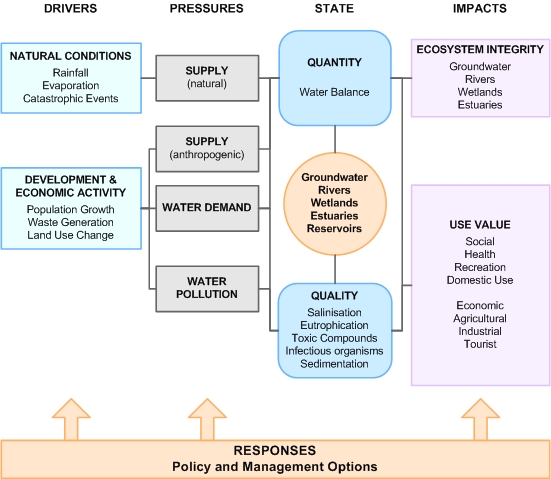
Figure 4. The DPSIR scheme
adopted in the investigation of causal interrelationships for the water
stress conditions in the 15 regions
|
4.2
An analysis of Water Stress Conditions
|
Water stress conditions and the
spectrum of circumstances were analysed in the 6 countries and within the
specific regions. The main observation made was that aridity should be
understood in a wider context encompassing both natural and man-made processes.
Various concepts have been used to exemplify a prevailing confusion among such
terms which signify dry environments or water deficiencies. The terms vary all
the way from the extremes of desert to aridity, to drought and to temporary
water shortages [9],[15]. There are four different terms that are important to
the initial separation between physical and social conditions with regard to
what one can summarily label water deficiencies:
-
Aridity, signifying a permanent natural
condition and a stable climatic feature of a given region,
-
Drought, referring to a temporary
feature of the climate or to regular or unpredictable climatic changes,
-
Water shortage, a term that can be
understood mostly as a man-made phenomenon reflecting the concern with
temporary and small area water deficiencies, and
|
-
Desertification, as a process of
alteration of the ecological regime often associated with aridity and/or
drought but principally brought about by man-made activities which change the
surrounding ecosystem to a significant degree.
At the same time,
responses to water deficiency problems, technological and social, as well as
legal mechanisms for carrying out management schemes tend to fall under the
following four major categories:
-
Strong incentives for efficient or new
uses, including economic benefits, redefinition of the doctrine of beneficial
use, etc.
-
Structural changes, such as new
organizational arrangements, creation of new water agencies, etc.
-
Regulatory counter incentives, such as
stricter enforcement and pricing policies.
-
Changes in water lifestyles and
cultural practices.
|
4.3
A Typology of Water deficiency types
|
The range of circumstances in the 15
regions was analyzed on the basis of a series of well-defined indicators
describing various issues of water management, such as water availability,
water quality, use patterns and types of demand pressures (seasonal,
permanent), pricing systems and tariffs, social capacity building, and
institutional framework (water competent authorities, decision making processes
and development priorities).
|
On the basis of the spectrum of water
management circumstances and the DPSIR causal interrelationships in the 15
regions, a typology for water stress conditions was proposed (see fig. 5) that
follows the above analysis of water stress conditions. The typology categorises
the 15 regions into four broad Types with respect to the processes leading to
water stress, and to the water stress context - man-made or natural processes,
causing temporary or permanent water deficiency.
|
|

Figure 5. The proposed
typology of water stress conditions
|
4.4
Selection of Case Study regions
|
Following
the elaboration of water deficiency types and the DPSIR causal
interrelationship analysis, Case Study regions were selected from the 15
proposed and analysed regions. A Case Study involves the application and
analysis of a Water Resources Management Paradigm [8],[10],[11],[12] on the
selected Region and its specific characteristics. It was important to select a
set of regions that represent the widest possible range of water stress issues
and conditions and their combinations, in order to ensure that the lessons
learned from the Case Studies would have the widest applicability possible. To
that end, the following six regions were selected:
-
Paros Island in the Cyclades complex
was selected in Greece, where the main water stress issue is the peak in demand
during the summer months, due to the high tourist influx onto the island. The
existing infrastructure capacity is stretched during that period and is often
insufficient to cover demand at peak times, leading to temporary shortages that
in return are damaging to tourism.
-
Cyprus was eventually selected as a
whole, in order to analyse the effects of the competition for water resources
between tourism and agriculture, the two major sources of income of the island,
and determine the potential for a compromising water management solution that
will be beneficial to both sectors.
|
-
Ribeiras do Algarve was selected in
Portugal, where despite the relative abundance of water resources, salinity of
the underground aquifers is a rapidly intensifying problem due to the
over-abstraction of water for use in golf courses and other tourism-related
uses.
-
Tel- Aviv and the Arava region were
eventually both selected for Israel, to be analysed with respect to the
conflicts arising between the provision of water for urban water supply and for
agriculture irrigation in a country where water is a very scarce and valuable
resource.
-
Belice Basin in Italy was selected,
where the major water stress reason is the peak in demand during the summer,
due to irrigation demands in the region.
-
Finally, Tenerife in the Canary Islands
was selected in Spain, where the year-round high water demand is caused by a
tourist influx much larger than the local population, demanding large
infrastructure that nevertheless needs to be paid for by the locals.
|
4.4.1
The Paros Case Study - stakeholder consultation
|
Paros Island has been used as a model
study to be used as a pilot for the subsequent analyses of the Case Study
regions. A survey of the "Base Case", the current state of the water system as
it presently stands was made, and data was collected on:
-
Water resources and hydrological data,
including rainfall.
-
Demand and consumption data and
forecasted trends.
|
-
Infrastructure, networks and water
allocation data.
In addition, all
available past and present proposed management plans were reviewed. This data
was used to formulate the dominant and emerging patterns in the Water
Management Paradigm of Paros (fig. 6), based on a DPSIR analysis of the
responses to water scarcity.
|
|
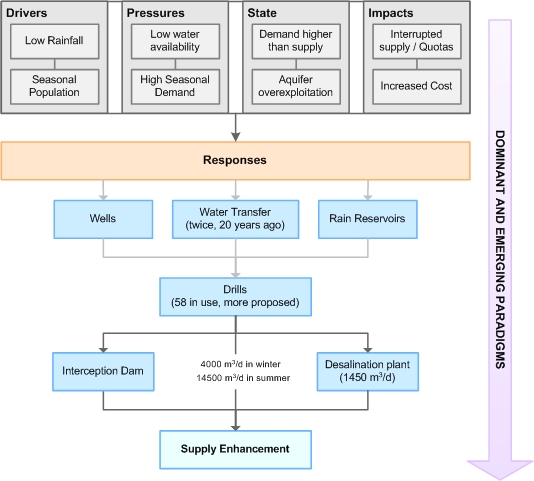
Figure 6. DPSIR analysis
and the Dominant and Emerging Paradigms in Paros Island, Greece
|
|
A very important source of information,
however, involved field work and consultation with the local stakeholders and
end users. Their opinions and perceptions on issues spanning the appropriate
allocation of available resources, the potential for water resources
development and the effectiveness of the current practices were collected, and
integrated into the Case Study approach. It became apparent that the approval
and the involvement of the local stakeholders and end users are imperative, in
order to maximise the success potential of any given strategy.
|
Special attention was therefore
given to their perception of how water resources management should be effected
in Paros, and how water stress should be faced.
Naturally, the
perceptions of the Water Utility and those of the end-users presented
differences. The Paros Water Utility suggested that appropriate solutions for
facing water stress involved the combined use of supply enhancement measures,
demand reduction measures and some socioeconomic interventions, such as
increased pricing (fig. 7).
|
|
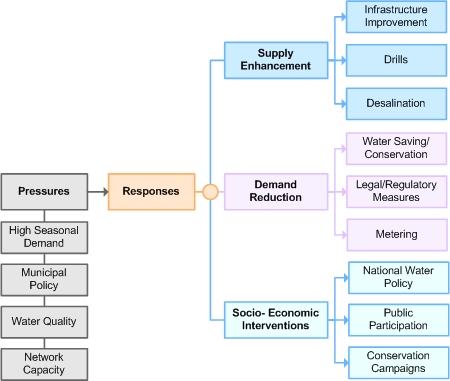
Figure 7. The Paros Water
Utility proposal for Water Resources Management
|
|
Consultation with the water users of
Paros however, farmers and room/hotel owners, showed that the majority believed
that mostly supply enhancement measures could provide a solution to the water
scarcity issues, while water saving technologies and conservation awareness
campaigns could make a small but significant contribution (fig. 8).
Increased pricing was not seen as a
viable solution and was rejected by most when asked.
|
Following
these consultation results, it was decided that the consultation process should
not only be taken into account in the formulation of strategies, but that it
should also be once again repeated for the formulation of the guidelines and
protocols of implementation of these strategies, making the most of the
stakeholders' experience and expertise.
|
|
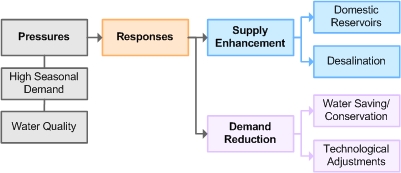
Figure 8. The Paros water
users proposal for Water Resources Management
|
4.5
The DSS and GIS Database
|
|
The GIS Decision Support System
developed aims to assess the state of a water resources system in terms of
sources, usage, water cycles (pathways) and environmental quality in a
simulation environment that responds realistically to external and internal
modifications. It has the potential to evaluate the effects of actions and
measures taken during the simulation, on the basis of the different scenarios,
alternatives and policies (table 1).
|
Within the simulation, water resources
are allocated according to a set of demand and supply priorities reflecting the
pricing system, social preferences, environmental constraints and development
priorities. The Decision Support System assesses water systems based on the
three principles of Integrated Water Resources Management:
|
|
Table 1. Summary of DSS
capabilities
|
DSS capabilities
|
|
Estimation of water availability
|
|
Estimation of the existing and projected water demands
|
|
Determination of the necessary interventions, their timeframe and cost
|
|
Determination of the optimal water allocation to uses
|
|
Provision of performance indicators for selected actions, under
availability and demand scenarios
|
|
Ranking of scenarios based on indicators
|
|
Estimation of the Rate of Cost Recovery, and of the Direct,
Environmental and Resource Costs
|
|
|
|
|
|
There are many ways of classifying
implementation approaches or policy options but of special importance for the
Decision Support System are the social system responses conceived as comprised
of four types of measures:
1. Supply measures, intended to
increase available water quantities during drought.
2. Measures aimed at decreasing water
demands through various conservation techniques and use limitations.
3. Measures needed to mitigate impacts.
4. Methods able to produce strategies
for management through mixes of control measures seeking optimum (efficient and
effective) solutions.
The main instruments, also called
"Policy Options" for the purposes of the project, used for developing IWRM
strategies in the selected Case Studies that are being analysed in their
application by the DSS include:
1. Supply management through structural
interventions which attempt to enhance fresh water supply (traditional or
pioneering ones such as desalination or water reuse).
|
2. Demand management through reduction
of losses, diminishing of overconsumption.
3. Finally, socio-economic instruments
such as:
-
Pricing, and
-
Changing of developmental regional
priorities.
The DSS can model
conditions in a given area/region and be used to estimate how much water is
needed to cover the existing and projected demand, to determine what
interventions are necessary, as well as when and where, and their cost (fig.
9). It can provide indicators of performance for selected actions under each
potential availability and demand scenario, and rank all available scenarios
based on these indicators [3],[4],[5],[6],[14]. It provides the user with the
ability to assess the functionality and performance of the water system within
the entire region of application as well as at individual points of
demand/interest. The DSS capabilities however do not extend to the assessment
of the performance of the managing authority, or the social impacts of the
actions applied.
|
|

Figure 9. The Decision
Support System conceptual model
|
5
Future Steps
5.1
Strategy formulation
|
|
The remaining steps until the end of
the project involve the completion of the Strategy Formulation Phase (phase 3)
and of the Synthesis and Dissemination Phase (phase 4). The critical stage of
Strategy formulation that is just being initiated includes the development and
assessment of coherent water management scenarios on water demands and
availability that will be used to evaluate alternative water management
strategies, set against the base case in each case study.
The scenarios include 3 components: a
demand scenario component that involves demand forecasting, a hydrological
scenario component based on existing hydrological series and/or hypothetical
time series, and finally an intervention, meaning a management measure, action
or sequence of actions.
|
These interventions refer to both
supply and demand-side measures, as well as economic instruments, that are
available for the management of water resources. The approach is adaptable, to
suit regions with similar characteristics, as opposed to rigid and tailor-made
for the specific region of application.
The comprehensive
scenarios will be evaluated against the base case to provide a ranking of
selected measures and/or strategies with respect to their performance and
applicability in the conditions of the water system analysed in the DSS
simulation (fig. 10).
|
|
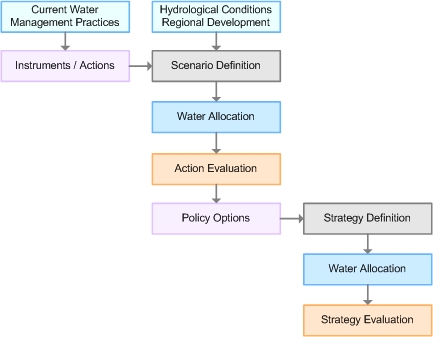
Figure 10. Steps in
Scenario and Strategy Evaluation
|
|
The next step, the Formulation of
Strategies [7] for IWRM will involve the planning of combinations of such
interventions/ management measures within a set timeframe, and re-evaluating
the resulting strategies in their entirety. This will be done using the DSS, as
previously done for each measure individually, and will enable the ranking of
the selected strategies for each Case Study and the selection of the best
suited approaches.
|
The criteria used for the evaluation of
the strategies are assigned user-defined weights, ensuring that the
applicability of the developed strategies covers not only a wide range of
circumstances, but can also be assessed based on the individual priorities
assigned to different aspects of water resources management by the end-users
and stakeholders.
|
5.2
Synthesis of results
|
|
The
final stage of the project will be the development of Guidelines and Protocols
of Implementation for Integrated Water Resources Management Strategies. The
Strategy formulation results will be elaborated into two sets of "instructions"
to be disseminated to water sector stakeholders and decision makers.
-
The Guidelines will provide a step-by-step analysis of the specific tasks to be
undertaken within the framework of a strategy and their specifications
(relative costs, duration, and project lifetime). They will analyze the
specific strategy into actions required within the selected water management
options, set within a suitable but flexible time framework. They will provide
the results of the strategy evaluation as well as the constraints and risks
involved in each identified Paradigm:
-
The evaluation of the lessons learned
by the analysis,
-
The selection of appropriate scenarios
for water resources management,
-
The identification of common
characteristics and patterns in the alternative strategies, and
-
The synthesis of the identified
strategies and development of general guidelines applicable to water deficient
regions.
|
-
The
Protocol of Implementation for a Strategy will provide the set of accompanying
measures required to create the Enabling Environment for its implementation.
They will encompass the sets of prerequisite measures that are required for the
implementation of each strategy, as those are elaborated by the Stakeholders,
and step-by-step instructions for their execution. The protocols will
incorporate the guidelines and the identified ranges of existing circumstances
and will provide codes for accepted as appropriate and correct policies of
integrated water planning following the:
-
Evaluation of water management
inefficiencies identified by the analysis, and
-
Evaluation of the water management
institutional structures and their inadequacies.
|
|
|
|
[1] European Environment Agency
(EEA), Sustainable use of Europe's water? State, prospects and issues,
Environment Assessment Series, 2001.
[2] Global Water Partnership
Technical Advisory Committee, Integrated Water Resources Management, TAC
Background Papers No.4, Global Water Partnership, March 2000.
[3] Mediterranean Commission on
Sustainable Development (MCSD), Indicators for the sustainable development in
the Mediterranean region, PlanBleu, 2000, URL: www.planbleu.org
[4] OECD (Organisation for
Economic Co-operation and Development), Environmental indicators, towards
sustainable development, OECD, 2001.
[5] Plan d'Action pour la
Méditerranée, Observatoire du Sahara et du Sahel, Les Indicateurs de l'Economie
de l'Eau, Ressources et Utilisations, Document de réflexion, Plan Bleu 1996.
[6] World Bank, Environmental
Performance Indicators, A Second Edition Note, Environmental Economic Series,
World Bank Environment Department, 1999.
[7] World Bank Group, A Guide to
the Formulation of Water Resources Strategy, World Bank Technical Paper no.
263, World Bank, November 1994.
[8] Allan, Tony, Millennial
Water Management Paradigms: Making IWRM Work (Source:
www.mafhoum.com/press/53aE1.htm).
|
[9] Bailey, RG., Ecoregions: The
Ecosystem Geography of Oceans and Continents. New York, Springer- Verlag, 1998.
[10] Gleick, Peter. H., The
Changing Water Paradigm: A look at Twenty-first Century Water Resources
Development, Water International, Volume 25, Number 1, Pages 127-138, March
2000.
[11] Grigg, Neil S., A New
Paradigm for Water Management, Colorado State University (Source:
www.ufrgs.br/iph/simposio/grigg.doc).
[12] Kuhn, Thomas, S., The
Structure of Scientific Revolutions, Second Edition, Enlarged, The University
of Chicago Press, Chicago, 1970 (1962).
[13] Margat J., Vallee D., Water
Resources and uses in the Mediterranean Countries: Figures and Facts, Blue
Plan, 2000.
[14] Rogers, P., Bhatia, R., and
Huber, A., Water as a Social and Economic Good: How to Put the Principle into
Practice, Global Water Partnership Technical Advisory Committee, TAC Background
Papers No.2, Global Water Partnership, 1998.
[15] Vlachos, E.C., "Drought
Management interfaces", Annual ASCE Meeting, Las Vegas, Nevada, 15p, 1982.
[16] Walmsley, J., Framework for
measuring sustainable development in catchment systems, Environmental
Management, Vol. 29. No2. 2002.
|
|
|
|
